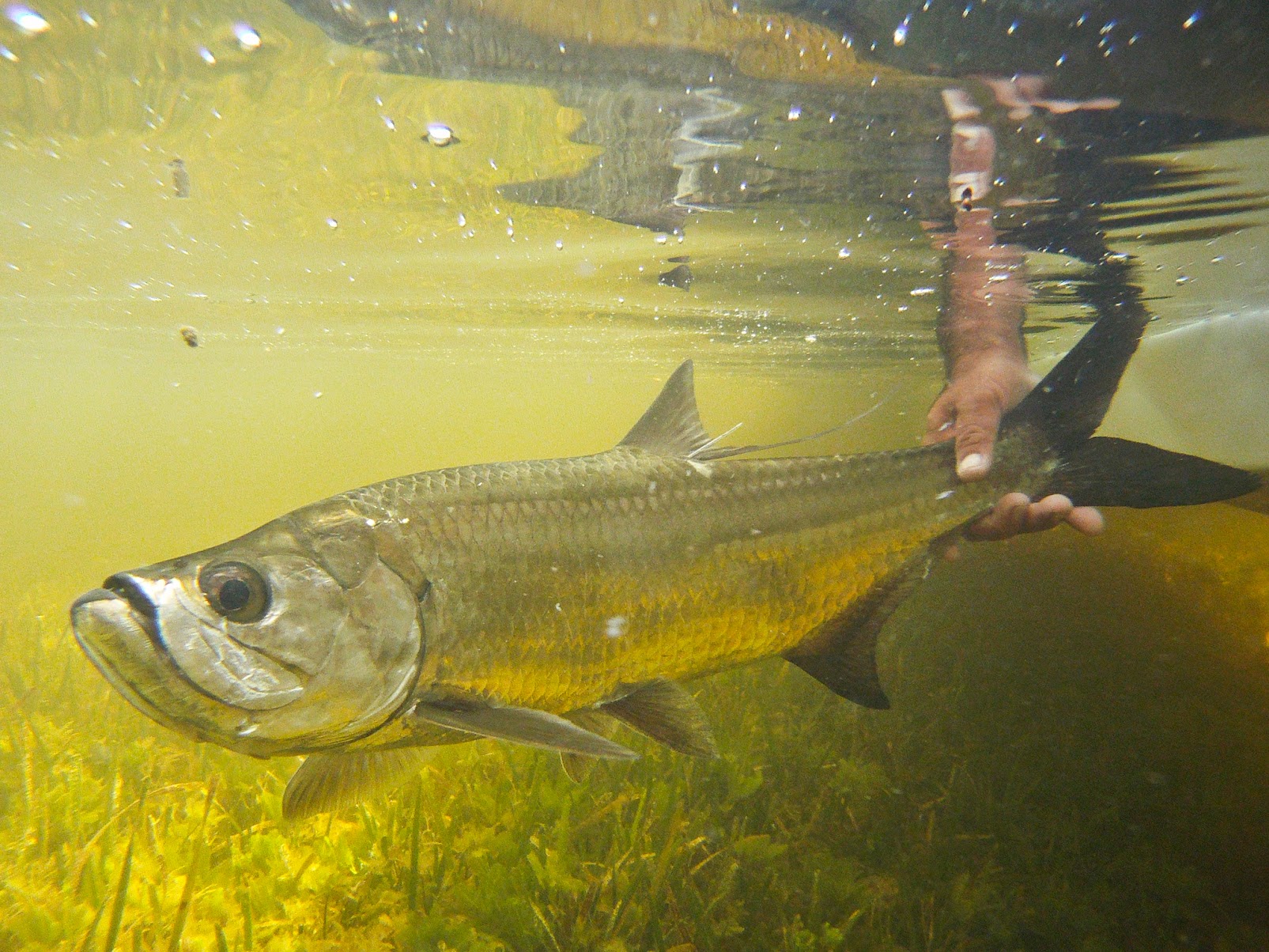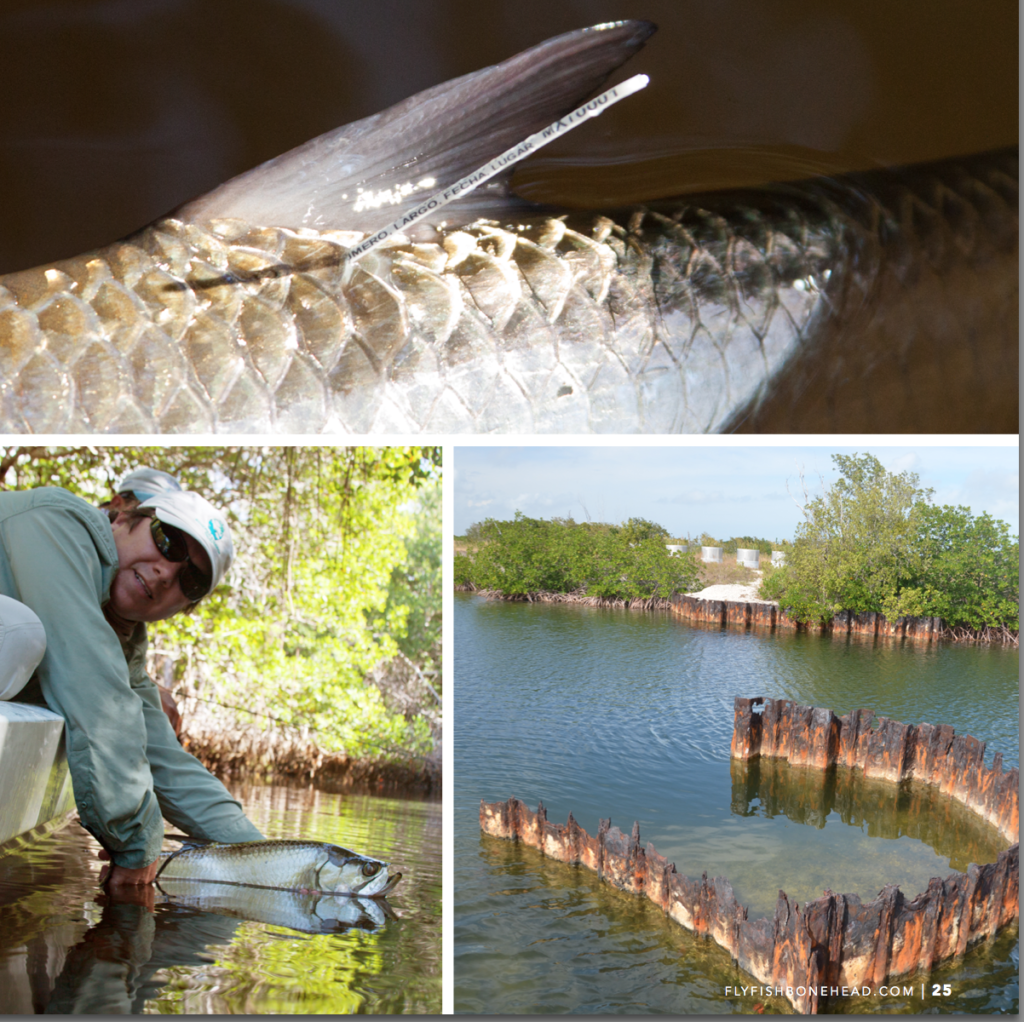Where do Babies Come From?
FLY FISHING FOR JUVENILE TARPON
It’s the time of year that flats anglers of South Florida woefully watch the steady stream of migrating tarpon become a mere trickle as the weather turns unbearably hot and sticky, and we are forced to turn our focus to other fish. Summers in Florida are a great time to target redfish, snook, and juvenile tarpon on fly, and the latter is one of my favorites because they aggressively take flies and are as acrobatic as their adult counterparts.
The Habitat
Juvenile tarpon in the one to three foot range use a variety of different habitats, but the common factor is often mangroves, which provide juveniles with the cover they need to avoid predatory birds and larger fish.Tarpon also have the advantage of a modified swim bladder, enabling them to survive
in water that has very little oxygen (and thus few large predators) by rolling and gulping air at the surface. Juvenile tarpon can survive in a variety of conditions, including fresh water.
When you begin your search for juvenile tarpon, look for dark, stagnant mangrove swamps and creeks that have at least some tidal connection to larger waters.These areas will have lots of cover, mosquitoes, and murky chocolate water, and are usually hard to get to. Basically, the last place any reasonable person would go is the perfect place to find little tarpon.
I have also caught baby tarpon in more easily accessible mangrove-lined shorelines inside of protected bays. Sometimes they roam the shorelines
in schools and can be seen from a great distance and are easily caught if
you put a fly in front of them, just as you would target the bigger migratory fish.These schools can be easy to spot if fish are rolling or throwing wakes
in calm waters, so just find a nice shoreline and start looking. Sometimes smaller groups of fish will hold in and around mangrove roots in these areas, and can be spotted when they sneak out to roll or feed on bait.
Satellite maps and charts can be a big help as you hunt for the right spot to target juvenile tarpon.Tarpon nurseries are scattered throughout Florida and other places where tarpon are found.You can make some pretty good guesses about where they might be by scouring local charts, looking for smaller protected creeks and pools that lead to larger bodies of water that provide easy access for tarpon to move to as they outgrow their nurseries.Then you get to head out on an adventure to see if those spots hold juvenile tarpon.
Once you figure out where these little guys are, the big question is how to successfully target them with a fly rod. Some of these areas can be hard to get to and require either a very small skiff or even better, a low-profile solo vessel like a kayak, canoe or paddleboard. Be very careful to arrange your gear before charging into a dense mangrove creek to minimize the chances of breaking a rod, getting your fly line tangled in a branch, or your gear bag snagged by a branch and dumped into the water. In certain areas, you can actually bushwhack your way in on foot, but be prepared to battle through a swarm of mosquitoes and foul-smelling, mucky terrain. However you access these spots, make sure you’re aware of the tides so you don’t get stranded somewhere.
The Gear
I like to use a fairly light rod to target small tarpon. A nine weight will make it a fun battle but allow you to land the fish without exhausting them or losing them to the mangroves. Plus, this size rod can handle the juveniles on the larger side, which can put up quite a fight.
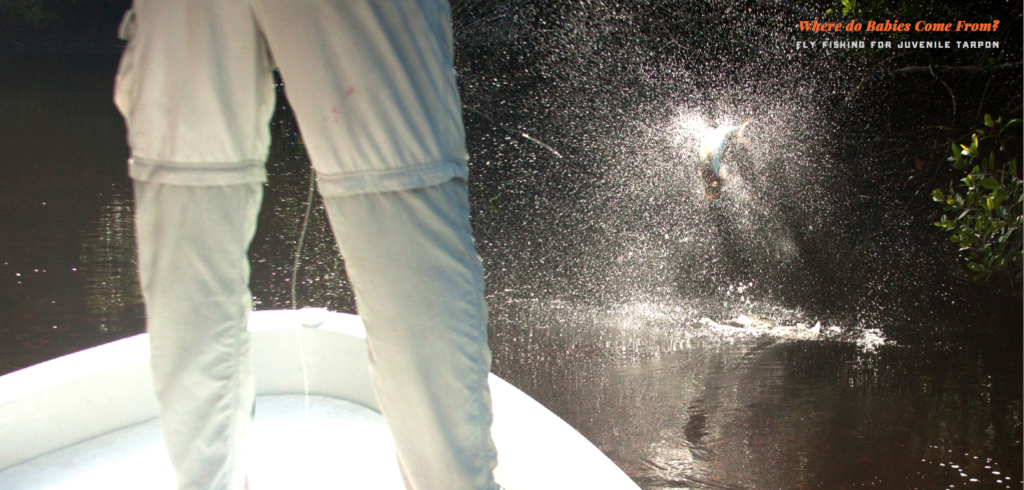
Depending on the depth where you’re fishing, a sinking line can be an asset. I sometimes use an intermediate sink tip because it is versatile enough to get down in deeper areas but also works in shallower spots. In really shallow waters, a floating line is the best bet.The shallows are my favorite because you can often sight cast to the fish, and I’ve had 20lb tarpon kick up sand as they charge a fly in a foot of water, which is an incredible sight. If you’re going to be fishing a variety of terrain, bring a rod rigged with a floating line and another with an intermediate or sink tip.
Like their adult counterparts, juvenile tarpon have the ability to wear down a leader, so strong shock tippet is a must. It’s fine to fish a straight 40lb leader, or a lighter leader with a little over a foot of 40lb shock tippet. Everyone has their preferences, but whatever you choose, you need to be able to put some muscle into it in case the fish makes a run for the mangrove roots.
For flies, I like to use small TARPON TOADS, EP and CLOUSER MINNOWS, and even GURGLERS (THIS MONTH’S FEATURED FLY) tied on 1/0 or 2/0 hooks. I like chartreuse, white and purple for colors. Anything that looks like a small baitfish tends to work well on juvenile tarpon, which tend not to be too picky about what they eat. And the floating flies, like gurglers, might be mistaken for the insects and tree frogs that fall from the mangrove branches. As with bigger tarpon, choose your fly based on the habitat, color of the water (you want the fly to contrast well), how the fish are behaving and what they are eating.
Tactics
If you’re fishing in an area with a lot of mangrove cover, you may have to make a lot of short roll casts to target fish while avoiding overhanging branches.
If you’re fishing shorelines trying to feed tarpon tucked away in mangroves,
you may need to really thread the needle or throw sidearm casts to get the fly under branches. And in more open water targeting schools on the move, a solid double haul is a must to get the fly in front of the fish in a hurry. Overcoming and mastering all of these challenges makes it that much more satisfying when you do manage to hook up. When you do convince a fish to eat, remember that like their older siblings, their mouths are very hard and require a strong strip set. Then, hang on tight and try to keep the fish from crashing into the mangroves.
The most important thing to remember as you explore juvenile tarpon fishing is to be patient and prepared. It may take you some time to actually find a juvenile tarpon honey hole, but it’s worth the effort when you do. And there is a great sense of adventure and oneness with nature when you set out in a kayak and squeeze your way into these seemingly untouched, narrow backwater habitats teeming with life, and are rewarded with amazing tarpon fishing.
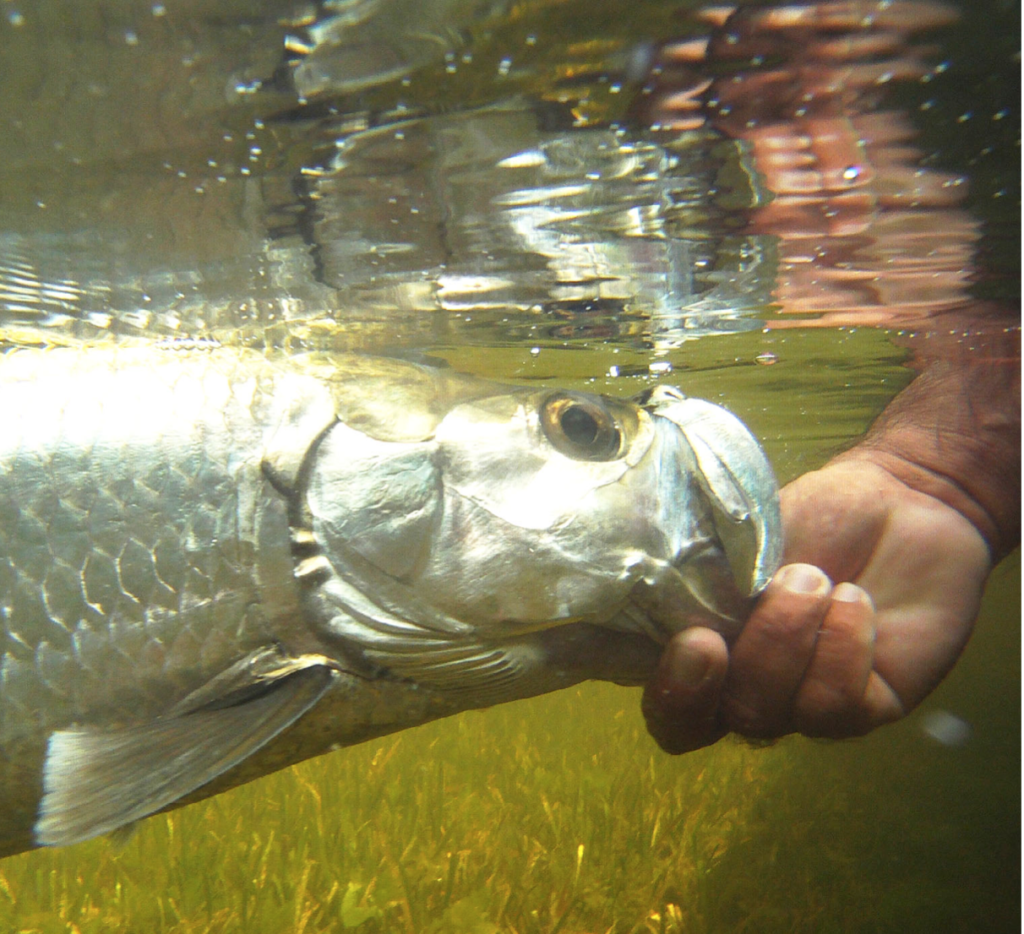
The Threat
A recent International Union for the Conservation of Nature scientific assessment classified tarpon as “vulnerable”, because of habitat loss and a population decline greater than 30% in the recent past. Mangroves are an essential habitat not only for juvenile tarpon, but for many species of gamefish and their prey, and unfortunately they are under threat worldwide. Globally, 35% of mangroves have been lost, and continue to be lost at a rate of 2%
per year. In Florida, 50% of mangroves have already been lost.The amount
of available habitat is one of the most important factors in determining population size, so the loss of mangrove habitats has direct effects on tarpon, snook, and all of the other fish they support. Because tarpon are a long-lived species that don’t become sexually mature until age 8-12 and live up to 80 years, impacts on the species might not be visible until a decade after the habitat is lost.
Juvenile tarpon require shallow, backwater habitats for at least the first year of their lives. Protecting these habitats is one of the biggest keys to sustaining tarpon populations in the long-term. Unfortunately, these nurseries tend to be in close proximity to urban areas, have already declined in coverage and quality and are under constant threat. Even when coastal mangroves and
salt marshes are protected, freshwater flow patterns have often been altered, which can degrade the habitat quality of adjacent mangroves and marsh habitats.This is where habitat restoration comes in.
Juvenile tarpon habitat restoration is truly an investment in the future of the fishery with long-term and widespread implications. Bonefish and Tarpon Trust is working hard to learn about juvenile tarpon habitats so that we can help guide restoration efforts throughout the United States and eventually other parts of the world. BTT just completed a first of its kind juvenile tarpon study at Wildflower Preserve, near Boca Grande Pass, and is starting up a second project in a part of Coral Creek with six manmade canals, on land owned by the Florida Department of Environmental Protection.The first year of the project will establish a baseline with a monthly tag-recapture sampling program that will allow us to estimate survival, growth and movements of juvenile tarpon within the restoration system. Some tarpon will be implanted with a PIT tag (like a pet microchip) that will allow us to track tarpon movement within and out of the system when tarpon swim by the strategically placed antennae. After the first year, the six canals will be restored using two experimental approaches, and BTT will spend the next two years monitoring the results of the restoration to determine which type of restoration is most effective.
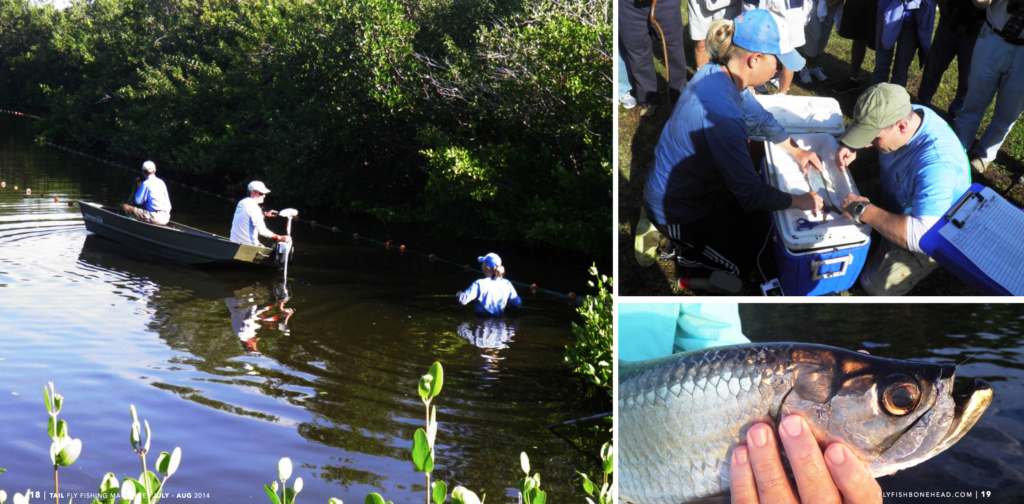
The implications of these efforts are huge, because they will provide data on juvenile tarpon habitat restoration that are not yet available—can restoration provide nursery habitat for juvenile tarpon? If juvenile tarpon
survival and growth rates are high, the habitat will be considered suitable and of good quality. And if emigration rates out of the system to nearby creeks are high, we will know that large numbers of juveniles have survived and successfully left the nursery habitats to contribute as part of the adult population. BTT is already in talks with other management agencies to take on similar projects elsewhere, and the hope is that these restorations can be replicated on a wider scale so we can really make
a difference in tarpon populations worldwide.
photo credit:
Cole Fairbanks, Aaron Adams and Lee Anderson.

